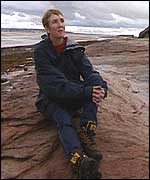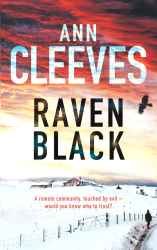|
Ann Cleeves has twice been short
listed for a CWA Dagger Award - once for her short story The Plater, and the
following
year for the Dagger in the Library award. In 2006 she won the Duncan
Lawrie
Dagger Award for best crime novel of the year for Raven Black, the first volume of her Shetland Quartet.
Now comes the follow up, White Nights.
SHOTS asked Ann to tell us about the new book and why the sense of
placement is
so important to her.
I first visited
Shetland more than 30 years ago. I’d
dropped out of university and an acquaintance phoned up out of the blue
to ask
if I fancied being assistant cook at the Bird Observatory on Fair Isle.
The observatory was desperate for seasonal staff, he said. Obviously desperate,
because I couldn’t cook
and knew nothing about birds. I
wasn’t
even sure where Fair Isle was. But it was an adventure
and it was work, so I
went. Fair Isle is the most
southerly of Shetland’s
islands, about half way between Orkney and Shetland mainland.
I loved Shetland.
It’s not a pretty place - it can be hard and
bleak - but it has a drama that appealed to me immediately and I
arrived in the
spring when it’s softened by masses of wild flowers and
seabirds. Fair Isle was full of
gossip and stories – great preparation
for a writer of fiction. I
worked there
for two seasons and like all the observatory staff I got involved in
the
rituals and rhythms of island life.
We
helped with the harvest and to round up the sheep for clipping. There were dances and
weddings and the week
was marked by the return trip of the mail boat on Tuesdays and Fridays.
 White Nights is the
second book in the Shetland Quartet and uses
my Fair Isle experience
more than the first
novel. Raven Black is set in mid-winter.
Although I’ve visited Shetland in the darkness
of January, I haven’t
lived there in the winter months.
The
first book is about what it is to be an outsider, about teenage
loneliness. It
introduces my central
character Jimmy Perez who, although his family has lived in Shetland
for
hundreds of years, is something of an outsider himself.
His ancestor was a Spaniard, shipwrecked from
an Armada boat. Perez
has a strange name
and Mediterranean colouring. And
he’s a
Fair Islander. He’s
worked in the south,
only coming back to Shetland when his marriage breaks down. He always saw his future
as a crofter, but
when that possibility arises in Raven
Black, he’s ambivalent about moving home to Fair Isle.
He decides after all to remain a cop.
White Nights is the
second book in the Shetland Quartet and uses
my Fair Isle experience
more than the first
novel. Raven Black is set in mid-winter.
Although I’ve visited Shetland in the darkness
of January, I haven’t
lived there in the winter months.
The
first book is about what it is to be an outsider, about teenage
loneliness. It
introduces my central
character Jimmy Perez who, although his family has lived in Shetland
for
hundreds of years, is something of an outsider himself.
His ancestor was a Spaniard, shipwrecked from
an Armada boat. Perez
has a strange name
and Mediterranean colouring. And
he’s a
Fair Islander. He’s
worked in the south,
only coming back to Shetland when his marriage breaks down. He always saw his future
as a crofter, but
when that possibility arises in Raven
Black, he’s ambivalent about moving home to Fair Isle.
He decides after all to remain a cop.
 Any second book
is tricky, especially if the first has been well received. There’s the
weight of expectation, besides
the danger of becoming stale and repetitive.
I hadn’t intended more than one book to be set
in Shetland – it was only
when my German publisher wanted details of the rest of the series, that
I
jotted a brief synopsis for the next three books.
It took no more than ten minutes and hardly
seemed real then. I
didn’t really think
the deal would be made. Coming
back to
the scrappy description a year later, I was horrified.
Could I really turn this outline into a
believable novel? The
synopsis featured
a stranger to the islands who seemed to be suffering from amnesia and
was then
found dead. It
didn’t seem much of a
plot. Then Ingirid,
a close Shetland
friend described seeing a young fiddle player perform.
‘He’s such a showman,’ she
said. ‘He
fell to his knees, still playing and he
didn’t miss a beat.’
That image stayed
with me and fed into the story.
Any second book
is tricky, especially if the first has been well received. There’s the
weight of expectation, besides
the danger of becoming stale and repetitive.
I hadn’t intended more than one book to be set
in Shetland – it was only
when my German publisher wanted details of the rest of the series, that
I
jotted a brief synopsis for the next three books.
It took no more than ten minutes and hardly
seemed real then. I
didn’t really think
the deal would be made. Coming
back to
the scrappy description a year later, I was horrified.
Could I really turn this outline into a
believable novel? The
synopsis featured
a stranger to the islands who seemed to be suffering from amnesia and
was then
found dead. It
didn’t seem much of a
plot. Then Ingirid,
a close Shetland
friend described seeing a young fiddle player perform.
‘He’s such a showman,’ she
said. ‘He
fell to his knees, still playing and he
didn’t miss a beat.’
That image stayed
with me and fed into the story.
 White Nights is set in
mid-summer, in what Shetlanders call ‘the
simmer dim’. I spent two summers in the islands, and the
writing allowed me to
revisit the Shetland of my youth.
I did
go north to stay with Ingirid for a week in June when I was working on
the
book, but it was continually pouring with rain and didn’t
provide the
atmosphere I was looking for, so I had to rely on memory and
imagination. In
good weather this far north midsummer is a strange time of light
evenings and
no real night. The
sun slides towards
the horizon and then climbs back into the sky again.
I wanted the new book to be less gloomy, less
dark than Raven Black. It’s about the
glitter of celebrity and about
deception; this is the time of year when nothing is quite as it seems.
White Nights is set in
mid-summer, in what Shetlanders call ‘the
simmer dim’. I spent two summers in the islands, and the
writing allowed me to
revisit the Shetland of my youth.
I did
go north to stay with Ingirid for a week in June when I was working on
the
book, but it was continually pouring with rain and didn’t
provide the
atmosphere I was looking for, so I had to rely on memory and
imagination. In
good weather this far north midsummer is a strange time of light
evenings and
no real night. The
sun slides towards
the horizon and then climbs back into the sky again.
I wanted the new book to be less gloomy, less
dark than Raven Black. It’s about the
glitter of celebrity and about
deception; this is the time of year when nothing is quite as it seems.
The book is set
in the fictional community of Biddista.
Artist Bella Sinclair grew up there and now that
she’s famous she still
lives in the big house on the hill, the former Manse, where admirers
have
always gathered to celebrate her work and feed her ego.
The Herring House Gallery on the shore nearby
exhibits her paintings. She
creates
illusions in her art and in her life.
It’s appropriate that the stranger who seems to
lose his memory is an
actor. Her nephew,
fiddle player Roddy
Sinclair is another professional performer and myths have already
started to
grow around him.
Also living in
Biddista are Kenny and Edith Thomson and I enjoyed writing about them
very
much. I wanted a
love story between
middle-aged people who have had to redefine their relationship over the
years. They married
because it was
expected – a choice of partners in such a small community
would be limited
after all! Kenny is
a crofter, turned
farmer, who still works the land in a traditional way.
Edith has become a professional woman: she
manages a care home for Shetland Islands Council.
Her horizons have been broadened by her
reading and by training trips to the south.
But as the couple’s interests have diverged,
their respect and affection
for each other has developed. Now
there’s
a tenderness, even a sexiness, between them that was missing in the
early days.
I started writing
crime fiction because I grew up reading the Golden Age novels of Sayers
and
Allingham. Setting
stories in Shetland
gives me the opportunity to write the sort of traditional rural murder
mystery
I enjoyed as a child. There
are few
other places in the UK where this
would be credible today, but
here we have the enclosed community, a way of life rooted in the
landscape, the
secrets it’s almost impossible to hide.
However, the Shetland of the twenty first century has
contemporary
problems and issues and to prevent the novels from becoming a pastiche
of
earlier detective stories, it’s important to consider those
too. This is a real
place, not some southerner’s
dream. The oil that
has provided
affluence for nearly half a century is starting to run out, some of the
young
men drink too much, apparently there’s a lot of depression. If tourism is encouraged
to replace oil
income, will the islands become a glorified theme park of spinning,
knitting
and music? I
don’t have the answer to
these questions but I enjoy exploring them through the fiction.
White Nights is
published by Macmillan April 2008 Harback £12.99
Read
Amy
Myers review of White Nights
For more
information on Ann visit her website
Read SHOTS’ 2006 interview
with Ann
Ann Cleeves
Bibliography
Palmer-Jones
Series
1. A Bird In The
Hand (1986)
2. Come Death and
High Water (1987)
3. Murder In Paradise (1988)
4. A Prey To
Murder (1989)
5. Sea Fever
(1991)
6. Another Man's
Poison (1992)
7. The Mill On
The Shore (1994)
8. High Island Blues (1996)
Inspector
Ramsay Series
1. A Lesson In
Dying (1990)
2. Murder In My
Backyard (1991)
3. A Day In The
Death Of Dorothea Cassidy (1992)
4. Killjoy (1993)
5. The Healers
(1995)
6. The Baby
Snatcher (1997)
Shetland Island
Quartet
1. Raven Black
(2006)
2. White Nights
(2008)
Novels
The Crow Trap
(1999)
The Sleeping and
the Dead (2001)
Burial of Ghosts
(2003)
Telling Tales
(2005)
Hidden Depths (2007)
|


